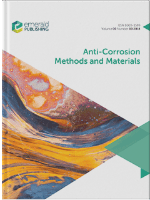
ANTI-CORROSION METHODS AND MATERIALS
Scope & Guideline
Pioneering Methods for a Corrosion-Free Future
Introduction
Aims and Scopes
- Corrosion Inhibition Techniques:
The journal emphasizes research on various corrosion inhibitors, including organic and inorganic compounds, and their mechanisms of action to enhance the corrosion resistance of metals. - Advanced Coating Technologies:
A significant focus is on the development and evaluation of novel coatings, including nanocomposite coatings, superhydrophobic coatings, and self-healing coatings that offer superior protection against corrosion. - Electrochemical Studies:
The journal publishes studies involving electrochemical methods to analyze corrosion behavior, including impedance spectroscopy, noise analysis, and other electrochemical techniques. - Material Characterization:
Research on the characterization of materials and their microstructures is prevalent, aiming to understand how microstructural features influence corrosion resistance. - Environmental Effects on Corrosion:
The impact of environmental factors such as temperature, humidity, and chemical exposure on the corrosion behavior of materials is a key area of investigation. - Machine Learning and AI Applications:
The application of machine learning and AI to predict corrosion behavior and optimize corrosion protection strategies is increasingly featured, highlighting a modern approach to corrosion science.
Trending and Emerging
- Nanotechnology in Corrosion Protection:
There is a growing trend towards the use of nanomaterials and nanocomposite coatings, which offer enhanced protective properties and have shown promising results in corrosion resistance. - Sustainable and Eco-Friendly Corrosion Inhibitors:
Research on green corrosion inhibitors derived from natural sources is on the rise, reflecting a broader trend towards sustainability in material science. - Integration of AI and Machine Learning:
The integration of artificial intelligence and machine learning for predicting corrosion behavior and optimizing protective strategies is increasingly prominent, highlighting a technological shift in the field. - Self-Healing Coatings:
The development of self-healing coatings that can autonomously repair damage and maintain corrosion protection is a rapidly growing area of interest. - Corrosion in Additive Manufacturing:
As additive manufacturing becomes more prevalent, studies focusing on the corrosion behavior of 3D-printed materials and their protective measures are emerging as a significant theme.
Declining or Waning
- Traditional Corrosion Testing Methods:
There seems to be a waning interest in traditional corrosion testing methods, such as salt spray tests, as researchers increasingly adopt more sophisticated and predictive modeling approaches. - Basic Material Studies without Contextual Applications:
Papers focusing solely on basic studies of material properties without direct applications or implications for corrosion resistance are becoming less common, as the field moves towards more applied research. - Corrosion in Non-Industrial Settings:
Research on corrosion in non-industrial or less critical environments is declining in favor of studies focused on industrial applications, especially in sectors like oil and gas, marine, and aerospace.
Similar Journals
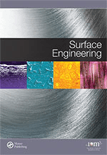
SURFACE ENGINEERING
Unveiling the Future of Material EngineeringSURFACE ENGINEERING, published by SAGE Publications Inc, is a premier international journal dedicated to the advancement of knowledge in the fields of material surface science and engineering. With an ISSN of 0267-0844 and E-ISSN 1743-2944, this esteemed journal has been a critical resource since its inception in 1985, and continues to thrive through 2024. Recognized for its impactful contributions, SURFACE ENGINEERING achieves notable rankings in several categories including Q1 in Conservation and Q2 in key areas such as Condensed Matter Physics and Materials Chemistry. The journal serves a diverse audience of researchers, professionals, and students, providing them with insightful research articles, reviews, and technological developments that drive innovation in surface coatings, materials chemistry, and related disciplines. Although the journal follows a traditional subscription model, it remains an essential platform for disseminating crucial findings and fostering collaborations within the scientific community.

Portugaliae Electrochimica Acta
Catalyzing Discovery in Electrochemical ProcessesPortugaliae Electrochimica Acta is a distinguished journal dedicated to the field of electrochemistry, published by the SOCIEDADE PORTUGUESA ELECTROQUIMICA. With a notable ISSN of 0872-1904, this journal serves as a vital resource for researchers, professionals, and students interested in advancing their understanding of electrochemical processes. Though it is currently categorized in Q4 in the 2023 Electrochemistry rankings, the journal contributes significantly to the academic discourse from its base in Coimbra, Portugal. The journal's timeline spans actively from 2008 to 2025, ensuring a sustained engagement with emerging research. While the journal does not offer open access options, it remains an authoritative source noted for promoting innovative electrochemical research and fostering academic connections within the discipline. Researchers are encouraged to submit their findings and explore the latest contributions to this expanding field.

Corrosion Science and Technology-Korea
Exploring the depths of materials performance and maintenance.Corrosion Science and Technology-Korea, published by the CORROSION SCIENCE SOC KOREA, is a pivotal journal dedicated to the exploration and advancement of knowledge in corrosion science, particularly within the context of materials performance and maintenance. Established to foster innovation and collaboration among scholars in South Korea and beyond, this journal focuses on areas such as electrochemistry, metal alloys, and surface coatings, catering to a diverse audience of researchers, professionals, and students in materials science and chemistry. Despite its current quartile rankings, including Q4 in Electrochemistry and Q3 in various materials-related categories, the journal aims to enhance its visibility and impact in the scientific community by publishing high-quality research and reviews. With its ISSN 1598-6462 and E-ISSN 2288-6524, Corrosion Science and Technology-Korea is committed to contributing to the understanding and mitigation of corrosion issues, thereby promoting sustainability and longevity in engineering applications.
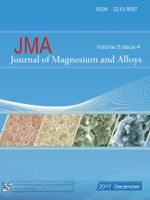
Journal of Magnesium and Alloys
Elevating Knowledge in Magnesium and AlloysThe Journal of Magnesium and Alloys is a prestigious, peer-reviewed academic publication dedicated to advancing the field of materials science, particularly focusing on magnesium and its alloys. Published by KEAI PUBLISHING LTD since 2013, this Open Access journal enables unrestricted dissemination of research findings, enhancing global collaboration among researchers, professionals, and students. With an ISSN of 2213-9567 and a significant impact factor, it has established itself in the upper quartiles (Q1) of both the Mechanics of Materials and Metals and Alloys categories, ranking #3 out of 176 and #9 out of 398 respectively according to Scopus. The journal aims to provide a forum for the latest advances in the understanding, production, and application of magnesium alloys, fostering innovation and sustainable practices within the materials engineering community. Based in Beijing, China, the journal is committed to bridging gaps in current knowledge and driving future research directions through its high-quality publications.

CORROSION
Exploring Corrosion Phenomena Across IndustriesCORROSION is a prestigious journal published by the Natal Association of Corrosion Engineers, dedicated to advancing the understanding of corrosion phenomena in various materials across multiple industries. With a strong commitment to high-quality research, it has established itself as a key resource in the fields of Chemical Engineering, Chemistry, and Materials Science, as reflected in its Q3 ranking in the 2023 category quartiles. This journal, retaining its relevance since 1969, serves as a platform for innovative studies and findings that address fundamental and applied aspects of corrosion, vital for professionals engaged in material selection and integrity management. Through access to state-of-the-art research, CORROSION significantly contributes to the safety, sustainability, and efficiency of engineering practices worldwide. Researchers, professionals, and students alike can benefit from the insights offered by this journal, driving forward the quest for innovative solutions in corrosion management.

SURFACE REVIEW AND LETTERS
Pioneering Studies in Surfaces and InterfacesSURFACE REVIEW AND LETTERS, published by WORLD SCIENTIFIC PUBL CO PTE LTD, is a pivotal journal in the fields of condensed matter physics, materials chemistry, and surfaces and interfaces. With an ISSN of 0218-625X and an E-ISSN of 1793-6667, this journal serves as a platform for cutting-edge research and innovative developments from 1996 to 2024. Despite its classification in the Q4 and Q3 quartiles for various categories in 2023, SURFACE REVIEW AND LETTERS emphasizes the importance of inter-disciplinary collaboration and the rapid dissemination of valuable insights, making it an essential resource for researchers and professionals eager to stay at the forefront of material science. Although currently lacking an open access option, the journal invites a wide range of submissions—fostering knowledge sharing among scholars and contributing to the advancement of the scientific community. Aspiring authors and readers will benefit from the opportunity to engage with diverse studies and methodologies, underscoring the journal's commitment to excellence in materials research.

npj Materials Degradation
Championing Open Access for Material Science Advancementsnpj Materials Degradation is a premier open-access journal published by NATURE PORTFOLIO that has rapidly established itself in the field of materials science since its inception in 2017. With its focus on the degradation processes affecting materials and their applications, this journal is essential for researchers and professionals seeking to advance their understanding of the longevity and sustainability of materials. The journal boasts an impressive impact, classified in the top quartile (Q1) of categories such as Ceramics and Composites, Materials Chemistry, and miscellaneous areas of Chemistry and Materials Science, as evidenced by its Scopus rankings where it ranks #17 in Chemistry (miscellaneous) and #27 in Ceramics and Composites. With open access options allowing for a broader dissemination of research findings, npj Materials Degradation serves as a vital platform for the dissemination of innovative research and interdisciplinary collaboration, enhancing the collective knowledge in the ever-evolving landscape of materials engineering and science.
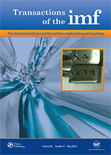
TRANSACTIONS OF THE INSTITUTE OF METAL FINISHING
Advancing Knowledge in Surface Engineering and Materials ScienceTRANSACTIONS OF THE INSTITUTE OF METAL FINISHING, published by Taylor & Francis Ltd, is a premier journal dedicated to the field of metal finishing and surface engineering. With an ISSN of 0020-2967 and E-ISSN of 1745-9192, this journal has been a critical resource for researchers and practitioners since its inception in 1969. Covering a broad scope that includes condensed matter physics, mechanics of materials, and the intricate science of metals and alloys, TRANSACTIONS OF THE INSTITUTE OF METAL FINISHING has established itself within the academic community, currently holding Q2 and Q3 rankings across multiple relevant categories in 2023. While not openly accessible, the journal remains a vital compendium of innovative research findings and advancements, attracting contributors and readers eager to explore cutting-edge developments in metal finishing techniques and applications. The insightful articles published here cater to a wide audience, including industry professionals, academic researchers, and students, who seek to improve their understanding of materials science and engineering practices.
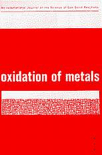
OXIDATION OF METALS
Advancing the Science of Metal DurabilityOXIDATION OF METALS, published by SPRINGER/PLENUM PUBLISHERS, stands as a pivotal journal in the fields of Inorganic Chemistry, Materials Chemistry, and Metals and Alloys. Established in 1969, it has consistently contributed to advancing knowledge and research on the oxidation processes in metals, essential for various industrial applications and theoretical frameworks. With an impact factor that reflects its respected position—ranked Q2 in key scientific categories—this journal facilitates cutting-edge discourse among researchers and practitioners alike. The journal is committed to open access, ensuring that groundbreaking research on metals’ behavior and resistance to oxidation is available to a broader audience, enhancing collaboration and innovation. Spanning over five decades, OXIDATION OF METALS continues to be a crucial resource for scholars and professionals aiming to stay at the forefront of materials science and engineering.

International Journal of Corrosion and Scale Inhibition
Unveiling Insights into Corrosion DynamicsInternational Journal of Corrosion and Scale Inhibition (ISSN: 2305-6894, E-ISSN: 2305-6894), published by VSEROSSIISKAYA ASSOTSIATSIYA KORROZIONISTOV, is a distinguished open-access journal dedicated to advancing knowledge in the critical fields of corrosion science and material degradation processes. Established in 2012, this journal serves as a vital platform for researchers, professionals, and students aiming to explore innovative solutions to corrosion-related challenges across diverse industries. Located in the Russian Federation, it boasts commendable rankings, placing it in the Q2 category for both Materials Chemistry and Metals and Alloys, signifying its significant impact within the scientific community. With a robust Scopus ranking—a commendable 40th out of 176 in Materials Science for Metals and Alloys and 120th out of 317 in Materials Chemistry—the journal highlights its pivotal role in disseminating research that shapes the future of material durability and sustainability. By fostering open access to scholarly work, the journal ensures that critical findings are accessible to a broad audience, thereby promoting knowledge sharing and collaboration in the quest to mitigate corrosion and enhance material performance.